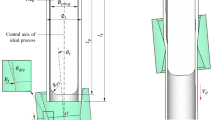Abstract
Cold tube drawing reduces the tube dimensions with closed tolerances and improves its mechanical properties. In this paper, there was an investigation into the cold drawing process with a floating plug using an upper bound analysis and energy method. The ring compression test was performed to determine the friction coefficient. Grooved pipe testing was done to determine the critical damage value. Simulation results confirmed the values of 0.05 for friction coefficient and 0.862 for critical damage value. Using the design of experiments with Taguchi method, the upper bound analysis was done and the correct design parameters were selected. For the selected parameters, the stress value of 289 MPa was obtained from the upper bound analysis. The design process was simulated using ABAQUS software and the results of the stress analysis at the die output showed the consistency of the upper bound analysis and simulation results.


















Similar content being viewed by others
References
Samipour S, Khaliulin V, Batrakov V (2018) Development of the technology of manufacturing Aerospace composite tubular elements by radial braiding. J Mach Manuf Reliab 47(3):284–289
Syed A, Samal M, Chattopadhyay J, Dutta P (2020) Fracture toughness evaluation of axially-cracked tubular thin-walled specimens of Zircaloy-4 and its implications for integrity analysis of nuclear fuel clad. Theor Appl Fract Mech 106:102449
Bortot P, Ceretti E, Giardini C (2008) The determination of flow stress of tubular material for hydroforming applications. J Mater Process Technol 203(1):381–388
Zhang L, Xu W, Long J, Lei Z (2015) Surface roughening analysis of cold drawn tube based on macro–micro coupling finite element method. J Mater Process Technol 224:189–199
Lee S-K, Jeong M-S, Kim B-M, Lee S-K, Lee S-B (2013) Die shape design of tube drawing process using FE analysis and optimization method. Int J Adv Manuf Technol 66(1–4):381–392
Shaheen L (2007) Tube drawing principles: understanding processes, parameters key to quality. In: The tube and pipe journal. The tube & pipe association, International, pp 10–28
Bramley A, Smith D (1976) Tube drawing with a floating plug. Metals Technology 3(1):322–331
Łuksza J and Sadok L (1983) Wybrane zagadnienia z ciągarstwa AGH
Gattmah J, Ozturk F, Orhan S (2020) A new development of measurement technique for residual stresses generated by the cold tube drawing process with a fixed mandrel. Int J Adv Manuf Technol 108(11):3675–3687
Rubio E (2006) Analytical methods application to the study of tube drawing processes with fixed conical inner plug: slab and upper bound methods. J Achiev Mater Manuf Eng 14(1–2):119–130
Świątkowski K, Hatalak R (2004) Study of the new floating-plug drawing process of thin-walled tubes. J Mater Process Technol 151(1–3):105–114
Rubio EM, González C, Marcos M, Sebastián MA (2006) Energetic analysis of tube drawing processes with fixed plug by upper bound method. J Mater Process Technol 177(1):175–178
Kwan C-T (2002) A generalized velocity field for axisymmetric tube drawing through an arbitrarily curved die with an arbitrarily curved plug. J Mater Process Technol 122(2–3):213–219
Cockcroft M (1968) Ductility and workability of metals. J of Metals 96:2444
Lee S, Ko D, Kim B, Lee J, Kim S, Lee Y (2007) A study on monobloc tube drawing for steering input shaft. J Mater Process Technol 191(1–3):55–58
Rubio E, Camacho A, Pérez R, Marín M (2017) Guidelines for selecting plugs used in thin-walled tube drawing processes of metallic alloys. Metals 7(12):572
Kuboki T, Nishida K, Sakaki T, Murata M (2008) Effect of plug on levelling of residual stress in tube drawing. J Mater Process Technol 204(1–3):162–168
Haddi A, Imad A, Vega G (2011) Analysis of temperature and speed effects on the drawing stress for improving the wire drawing process. Mater Des 32(8):4310–4315
Toribio J, Lorenzo M, Vergara D, Kharin V (2014) Influence of the die geometry on the hydrogen embrittlement susceptibility of cold drawn wires. Eng Fail Anal 36:215–225
Chobaut N, Drezet J, Mischler S, Nguyen V, De Marco B, Dobler S, Rosset E (2019) Miniaturized tube fixed plug drawing: determination of the friction coefficients and drawing limit of 316 LVM stainless steel. J Mater Process Technol 263:396–407
Cao TS (2017) Models for ductile damage and fracture prediction in cold bulk metal forming processes: a review. Int J Mater Form 10(2):139–171
Kong Z, Zhang J, Li H, Kong N (2018) Deep drawing and bulging forming limit of dual-phase steel under different mechanical properties. Int J Adv Manuf Technol 97(5–8):2111–2124
Farahani ND, Parvizi A, Barooni A, Naeini SA (2018) Optimum curved die profile for tube drawing process with fixed conical plug. Int J Adv Manuf Technol 97(1):1–11
ASTMA53, (2020) Standard Specification for Pipe, Steel, Black and Hot-Dipped, Zinc-Coated, Welded and Seamless. ASTM International, West Conshohocken, PA
Astm I, (2016) ASTM E8/E8M-16a: Standard Test Methods for Tension Testing of Metallic Materials. West Conshohocken, PA, USA: ASTM International
Kim S, Kwon Y, Lee Y, Lee J (2007) Design of mandrel in tube drawing process for automotive steering input shaft. J Mater Process Technol 187:182–186
Świątkowski K, Hatalak R (2006) Application of modified tools in the process of thin-walled tube drawing. Arch Metall Mater 51(2):193–197
Author information
Authors and Affiliations
Corresponding author
Ethics declarations
Conflict of interest
The authors declare that they have no conflict of interest.
Additional information
Technical Editor: Lincoln Cardoso Brandao.
Publisher's Note
Springer Nature remains neutral with regard to jurisdictional claims in published maps and institutional affiliations.
Rights and permissions
About this article
Cite this article
Pouyafar, V., Bolandi, H. & Meshkabadi, R. Tube drawing analysis using upper bound and energy methods and validation by Cockcroft-Latham failure criteria. J Braz. Soc. Mech. Sci. Eng. 44, 9 (2022). https://doi.org/10.1007/s40430-021-03302-z
Received:
Accepted:
Published:
DOI: https://doi.org/10.1007/s40430-021-03302-z



